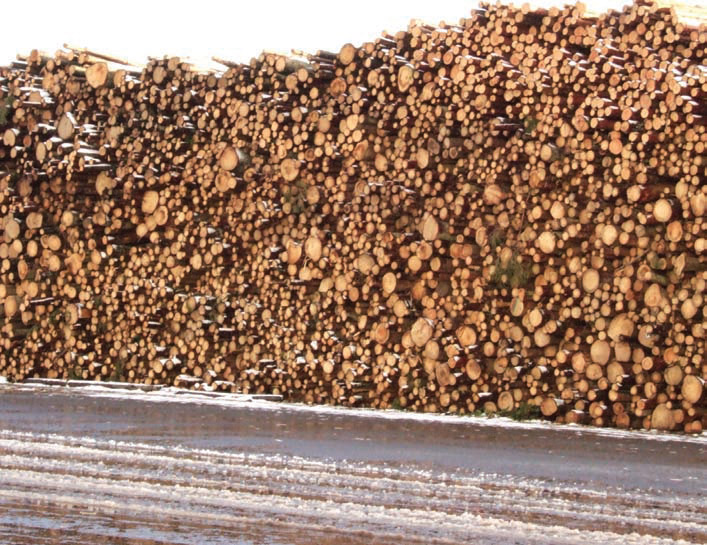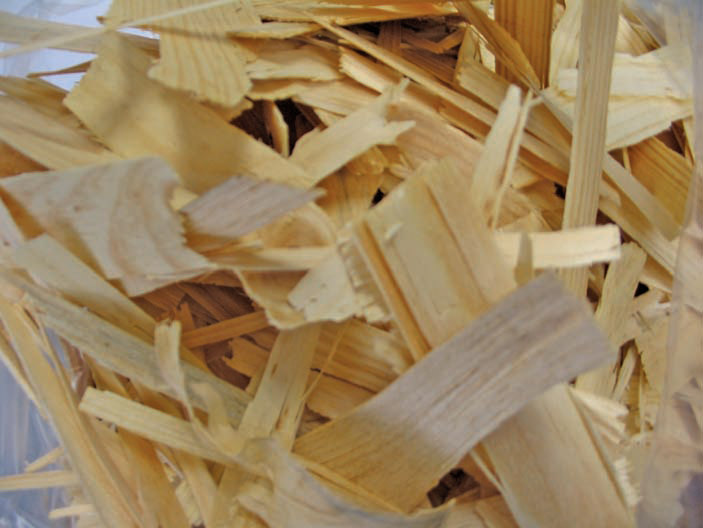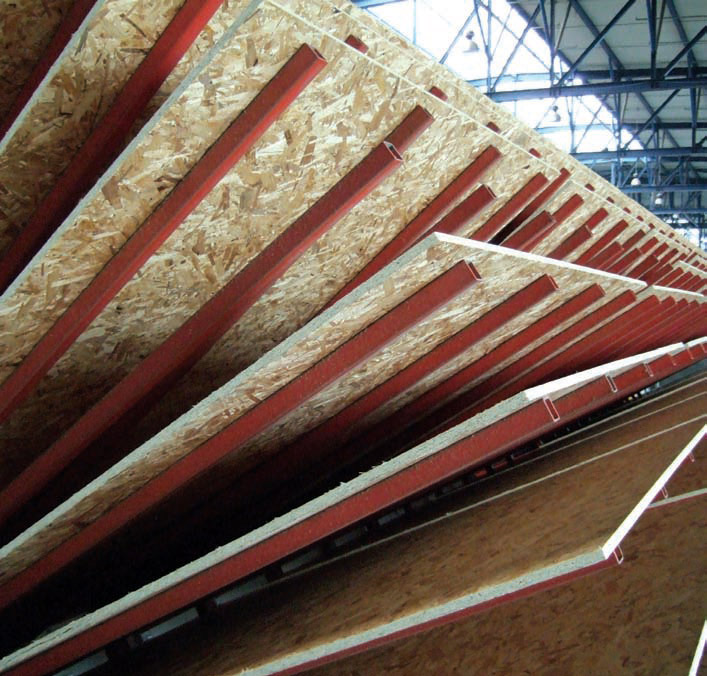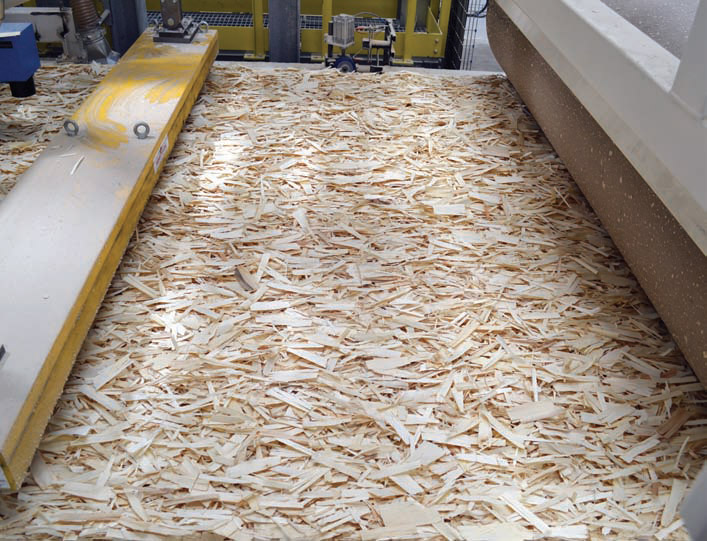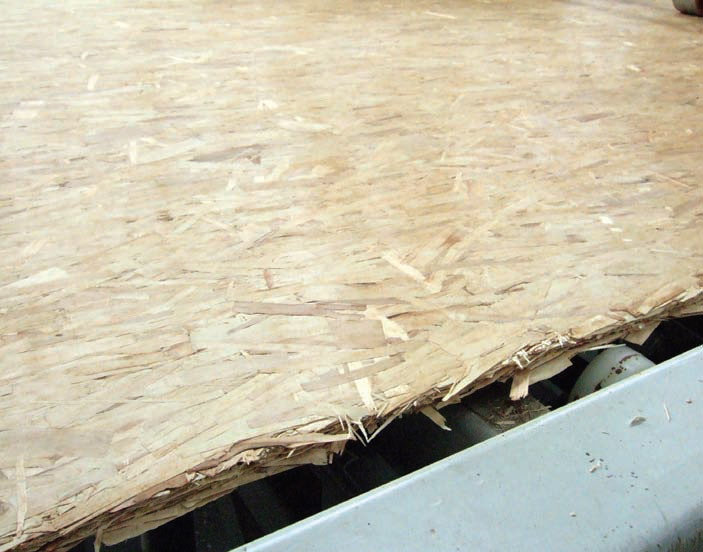Forecast brighter but variable
16 May 2016The always-small North American OSB league table is looking quite different to little more than a decade ago. However, consolidation, combined with restraint among leading producers as to how and when they restore curtailed capacity, should make for a brighter outlook, says our North American industry specialist.
Meaningful consolidation in the North American OSB industry took several years to unfold, given how hard the industry was hit by the economic and US housing market downturn. But unfold it did, with the exit and demise of some players and then, in 2015, the merger of two of the top 10 OSB producers.
Norbord Inc's merger with Ainsworth Lumber Co Ltd early in 2015 thrust the Toronto-based international panel products manufacturer to the top of the shrinking league table of North American OSB producers.
The merger, announced in December 2014, and completed on March 31, 2015, made Norbord the world's largest OSB producer, with total installed OSB capacity of 8.0 billion ft2 (3/8in basis).
According to information on Norbord's website, the company now has 2,600 employees at 17 plants (including its MDF and particleboard facilities) across the US, Canada and Europe.
OSB accounts for 90% of Norbord's global panel capacity, with particleboard 6% and MDF 4%. In North America, Norbord now accounts for 26% of the roughly 28 billion ft2 of total OSB production capacity, compared with Louisiana-Pacific Corp's (LP's) 22%.
The combination of Norbord's previous total North American OSB production capacity of 4.57 billion ft2, and Ainsworth's 2.54 billion ft2, took Norbord's North American OSB capacity to about 7.1 billion ft2, ahead of LP's 5.89 billion ft2.
Norbord now has 13 North American OSB mills (including Ainsworth's), of which six are in Canada. One Canadian mill, Val d'Or, Quebec (340 million ft2/year), and one US mill, Huguley, Alabama (500 million ft2/year) remained offline as of March 2016.
Louisiana-Pacific has five Canadian OSB mills of which one, Chambord in Quebec (470 million ft2/year) has been indefinitely shut since 2008.
All of LP's six US mills are believed to be operating, though a major investment is just beginning in the newest of its mills, Thomasville, Alabama (750 million ft2/year).
Early in January 2016, LP announced it had broken ground on a project that will add a FlameBlock fire-rated OSB sheathing line which the company expects to complete in the third quarter of 2016, with production scheduled to begin in the fourth quarter.
As previously reported, LP's Hayward, Wisconsin, siding mill no longer produces the small amount of OSB it had continued to produce following its conversion to siding around the same time the Thomasville mill was built, because demand for siding has been so strong.
LP also revealed plans in May 2015 to convert its Swan Valley, Manitoba OSB mill to SmartSide siding production, mainly for the US market, by the fourth quarter of 2015. As with Hayward, the Swan Valley mill site will still be able to produce OSB if required.
Georgia-Pacific LLC (GP) is the third largest North American OSB producer, with about 18% of the 28 billion ft2 OSB production capacity, if GP's annual production capacity is 5.04 billion ft2.
However, GP is a privately held company that will not comment on mill capacities and its total OSB capacity figure includes several mills in the southeastern US which have been indefinitely closed for years.
The GP capacity figure assumes that Dudley, North Carolina (170 million ft2/ year) is permanently closed (and has been since October 2006 according to publicly available information). Other long-curtailed GP mills - Grenada, Mississippi (375 million ft2/year), Mount Hope, West Virginia (375 million ft2/year), and Skippers, Virginia (365 million ft2/year) - are still included in GP's total capacity figure only because GP has never publicly confirmed that any of them are permanently closed.
However, GP does list its manufacturing operations on its website, state-by-state, and it does not list Grenada (curtailed in the fourth quarter of 2009) among its Mississippi manufacturing operations. Workers were granted Department of Labor Trade Adjustment Assistance after the mill was curtailed.
Mount Hope workers - 70 production staff were laid off in January 2009 - were also granted Trade Adjustment Assistance, and GP does not list this mill (or any other West Virginia mill) on its website.
GP also does not list Skippers, indefinitely curtailed in summer 2011, among its Virginia manufacturing operations on its website, although it does list the 400 million ft2/year Brookneal, Virginia, OSB facility - one of its operating mills.
Removing the 1.1 billion ft2 combined capacity of those three mills from GP's total would leave it with just under four billion ft2 of OSB capacity. That's still more than the next company in the league table, Weyerhaeuser Co, which has a rated OSB capacity of three billion ft2 out of six mills in the US and Canada. All Weyerhaeuser's mills are operating and, combined, represent about 11% of total North American OSB production.
Huber Engineered Woods LLC, and Tolko Industries Inc, each have about 8% of North America's total OSB capacity.
Huber has a rated capacity of 2.1 billion ft2 out of five OSB mills, but its 352 million ft2/year mill in Spring City, Tennessee has been indefinitely closed since 2011. When the mill closed, Huber described it as an indefinite closure, The Chattanoogan reported in October 2011. Spring City is not listed among the Huber Engineered Woods facilities on the parent company, JM Huber Corp's, website and analysts no longer include it in their list of Huber OSB facilities.
Tolko, when all its mills are operating, has about two billion ft2 of rated OSB capacity. For much of the past decade, only Meadow Lake, Saskatchewan (700 million ft2/year) was running. However, Tolko began ramping up its state-of-the-art Athabasca Division engineered wood facility (800 million ft2/ year) at Slake Lake, Alberta, in December 2013, bringing the mill back online in the first quarter of 2014.
Tolko has not discussed reopening the smaller, older, Slave Lake mill (250 million ft2/year), which was originally going to be switched over to value-added production to support the new Athabasca facility. Neither has it mentioned its High Prairie, Alberta, mill (640 million ft2/year), curtailed for market reasons in February 2008.
There has been no apparent change in status since last year for the mills owned by any of the remaining OSB companies in North America, which together account for 7% of total OSB production. They are:-
- Arbec Forest Products, with total rated capacity of 700 million ft2/year of OSB from its (294 million ft2/year) former Tembec OSB mill in St Georges de Champlain, Quebec; and the former Weyerhaeuser Miramichi, New Brunswick OSB mill (407 million ft2/year) which it acquired in 2012.
- Martco Limited Partnership (Roy O Martin), with 850 million ft2/year from its single OSB mill in Oakdale, Louisiana.
- Langboard in Quitman, Georgia (440 million ft2/year).
That looks to be about to change, however, as Martco is moving ahead with its plans to build a new OSB mill in Corrigan, Polk County, Texas.
The privately-owned Alexandria, Louisiana-based company has ordered equipment and scheduled start-up for the autumn of 2017. Investment in the mill, to be called Corrigan OSB LLC, is around US$280m, according to local media coverage, and it will employ 165 people. Roy O Martin's application to the Corrigan-Camden Independent School District for Appraised Value Limitation on Qualified Property describes the intended facility as being modelled on the company's existing OSB plant in Oakdale, Louisiana and having a capacity of around 800 million ft2/ year. The facility is being proposed on a 24/7 operating basis.
In December 2014, Polk County Commissioners voted to approve a 10-year tax abatement for the proposed OSB plant.
Norbord/Ainsworth merger
One of the benefits of the Norbord- Ainsworth merger to the companies themselves was that they serve separate and diverse regions with minimal overlap, CEO Peter Wijnbergen noted when the merger was proposed.
"This transaction represents an opportunity to unite Norbord's mill network, which is centred in the US southeast, with Ainsworth's assets which are primarily in the Canadian northwest, enabling the combined company to better serve customers across North America, which is still the leading consuming market for OSB.
"Combining Norbord's low-cost assets and larger mill footprint with the Ainsworth mills' innovation and value-added, strength based, engineered wood products, will support new product development and put us in a better position to meet the needs of our customers," said Mr Wijnbergen. Opportunities for the merged company to increase capacity were also touted, including the re-start of Norbord's idled mills in Huguley, Alabama and Val-d'Or, Quebec; and the completion of the second line at Ainsworth's Grand Prairie, Alberta, facility.
On January 18, 2016, Norbord announced that Quebec had withdrawn the company's wood licence for the Val d'Or mill, though Mr Wijnbergen indicated that Norbord still intends to re-open the mill at such time as the market allows and said the province had confirmed that the company would have the opportunity to re-apply for its wood licence when it is ready to re-open the mill.
Whether either of Norbord's curtailed mills re-open any time soon does not alter the fact the merger created, in the words of RBC Capital Markets analyst Paul Quinn, "The first 'truly global' OSB producer". In addition to its six OSB mills in the US Southeast and one in Quebec, Norbord has two OSB mills in Europe (see OSB Rest of the World feature on following pages), as well as other panel production.
Ainsworth's operations are located predominantly in western Canada and it ships about 82% of its output to North America and 18% to Asia, "with a leading position in Japan," RBC Capital noted.
Adding value
Having North American OSB production in the hands of fewer players has long been encouraged by investment analysts, who have witnessed a predictable pattern of feast and famine for many decades in the commodity OSB market - and that brings with it market volatility. Even with a shrunken field in terms of players, analysts who watch their fortunes still advise caution over bringing moth-balled capacity or mills online before market demand has sufficiently recovered.
In LP's conference call, one analyst asked executives: "Do you think this industry can 'get religion' on capacity management?"
As previously noted, the two biggest producers, Norbord and LP, still have mills offline, and Curt Stevens, CEO of LP, pointed out the downtime LP had taken during the year, adding: "If we are more real-time with the market and do not have an inventory overhang, that makes a lot of sense. So we are running our mills to respond to the demand that we have".
In Norbord's conference call in January, Mr Wijnbergen pointed out that, according to APA figures, 2015 actual OSB production, at 20.4 billion ft2, trailed installed capacity of the mills running today by some 4.2 billion ft2, "So that's why we are still thinking that it's too early to start additional capacity in North America right now".
Reducing their dependence on markets for commodity grade OSB is one way in which individual producers can retain a degree of control over their own destinies, regardless of who else is building or reopening mills.
LP has strongly positioned itself in the siding market. LP Swan Valley, as the converted plant is called, is the company's first and only Canadian mill producing SmartSide wood siding, according to an article in the Winnipeg Free Press.
Despite absorbing a cost in 2015 of about US$10m associated with Swan Valley's conversion, LP had its most profitable year ever in its siding business, said Mr Stevens in LP's financial conference call with analysts in February.
Later, in response to an analyst's questions, CFO Sallie Bailey said the US$120m to US$135m currently being reinvested in the company's growth was primarily going to the siding business, as well as capital maintenance and cost reduction.
Mr Stevens alluded to ensuring LP's siding capacity gets in front of demand, "So you will see in the next, probably two to three years, that we will have to do something to add additional siding capacity, because we believe Swan will only give us about two and a half years of headroom".
Asked if LP might be considering converting other mothballed mills to siding, Mr Stevens declined to be specific, for competitive reasons, but said: "We have a fellow who heads up all our procurement and logistics and forestry. He's got a team put together to look at exactly that - at sites that make logistical sense, that make sense from a personnel standpoint, and to look at equipment that we could redeploy most cost-effectively. So that was my comment about when you think about future capital, we do have to think about where the next mill goes to support the siding growth". Mr Stevens also noted that the value-added component of LP's OSB production grew from 40% in 2014 to 44% in 2015, largely through its FlameBlock, TechShield radiant barrier and flooring products. Asked for a projection on value-added OSB production in 2016, Mr Stevens said: "My objective is to get that over 50%, but I don't think we are going to do it this year. It will be in multiple steps".
Norbord's added-value component is 20%, CEO Peter Wijnbergen said in January. Asked by an analyst about raising that percentage in future, Mr Wijnbergen said: "We're still in the process of laying out a more detailed plan on how we're going to implement a move. Our objective is to grow that business beyond, let's say, the normal growth we would see in the recovering US OSB market".
He added that Norbord expected to be growing that volume this year, while also remaining "focused on our commodity business because it's where we see a lot of recovery in the near-term".
State of the market
With the exception of the new line at Grande Prairie, which Ainsworth had almost completed when the recession came along - and Martco's aforementioned proposed Texas mill - there are no longer any new OSB mills on the visible horizon for North America. The rush of projects announced a decade or so ago that were stalled by the recession all seem to have fallen by the wayside, even though the majority were announced with a bang and died considerably more quietly.
Roy O Martin's Texas project stands out, given major producers still have some of their existing capacity curtailed, though as executives from some of those companies have noted, privately-held Roy O Martin has one key advantage when it comes to capital investment: no shareholders.
Certainly, there seems very little, in either the mainstream housing forecasts or the industry-specific projections, to encourage anything other than 'proceed with caution' when it comes to restoring or adding OSB capacity.
According to statistics released in January 2016 by APA-The Engineered Wood Association, total North American structural panel production in 2015 was 31.037 billion ft2, up 1.2% from the 30.680 billion ft2 for 2014 and apparent consumption was up 2.9% to 30.971 billion ft2.
North American OSB production in 2015 was up 2.4% compared with 2014, to 20.357 billion ft2, with US production up 2.1% to 13.283 billion ft2 and Canadian production up 2.9% to 7.074 billion ft2.
US apparent consumption of OSB in 2015 was 18.158 billion ft2, up 5.7% compared with 2014, and Canadian consumption was 1.713 billion ft2, down 14.9% year-on-year, according to APA statistics.
US exports of OSB in 2015 (excluding shipments to Canada) were down 16.7% year-on-year, to 154m ft2, while Canadian OSB exports to markets excluding the US were down 34.3%, to 343m ft2. Canadian OSB shipments to the US in 2015 were up 14.2%, to 5.118 billion ft2.
In a market outlook put out in July 2015, APA forecast that, from 2015-19, demand for North American structural panels would grow by 19% compared with 20%- 25% growth during that period for other engineered wood products.
Whether those projections are realized is, of course, largely dependent on the direction and pace which the US housing market takes.
Early in January 2016, during an investor conference call organised by RBC Capital Markets, Greg Lewis of US industry research and consulting firm Forest Economic Advisors (FEA), gave a presentation on North American OSB markets.
FEA expects US housing starts to grow gradually from the one million total units (including both single-family and multifamily starts) clocked in 2014.
Projections from FEA are for total housing starts to rise to a little more than 1.2 million in 2016 and slightly more than 1.4 million in 2017.
Single-family housing, on which OSB is highly dependant, accounts for a large share of those starts, but single-family starts are forecast to grow to less than one million by 2017.
Home improvement expenditure - another important market - will improve, but remain well below the pre-recession peak in 2004-5, rising to about US$1.65bn by 2017, according to Mr Lewis' presentation. As end-use markets improve, so will demand for structural panels, with OSB demand (in all markets) projected to gradually increase to about 24bn ft2 in 2017.
Furthermore, Mr Lewis indicated that a broad-based recovery would boost OSB consumption across end-uses, with new residential construction still accounting for more than 14 billion ft2 - and approaching 60% market share - by 2017. Other key markets for OSB are home improvements, industrial, non-residential, construction and offshore exports.
North American OSB capacity is expected to grow as markets tighten, with FEA forecasting operable capacity to increase slightly in the next two years to reach a little under 29bn ft2 by 2017. The projection for effective OSB capacity, however, is somewhat lower, at less than 26bn ft2.
Average OSB prices will trend higher over the next two years, spurring capacity restarts in 2017, according to the FEA.
In LP's conference call with investment analysts in February, CEO Curt Stevens said that, while the news about the US housing market in recent months "continues to be good", it has not been as strong as forecast.
Median home prices in 2015 were up 7.6%, with December marking the 46th consecutive month of year-on-year gains; first-time buyers bought about 30% of the existing homes in 2015, up slightly from the previous year; and total housing inventories were 3% lower than a year ago, which Mr Stevens said was creating some shortages.
One bright spot in 2015 was the number of household formations, which at 1.7 million was significantly higher than in recent years. "This could mean that the 'Millennials' are finally on the move," said Mr Stevens (meaning the generation description for which most researchers and commentators use birth years ranging from the early 1980s to around 2000).
Many of those 'Millennials' have been kept out of the US housing market, not least by student loan debt. The US Federal Reserve recently valued outstanding student loan debt at more than one trillion US dollars. The California-based Home Buying Institute (HBI) noted in a report last October that debt-burdened 'Millennials' can face obstacles to securing a mortgage, thus delaying the entry of many into home ownership.
In its October 2015 report, the HBI was generally upbeat about the US housing market for 2016 and set out these predictions, in addition to its observations on 'Millennials':-
1. That home prices will rise more slowly in most US cities than in the past couple of years, as more homes come onto the market, restoring the supply-demand balance missing in many parts of the US housing market.
2. The biggest US home price gains will continue to be in the west, after 2015 saw double-digit property value increases in many Californian cities, as well as Denver, Colorado. Both Denver and San Francisco posted year-on-year gains in 2015 above 10%.
3. Mortgage rates will rise in 2016, which could lead to a slight reduction in home buying activity, potentially offset by continued improvements in the job market and broader economy.
4. Job gains will bring more home buyers into the market and that will coincide with a shortage of homes for sale, relative to demand in many US cities, which could continue to push up home prices in 2016 as buyers compete for limited inventory.
Housing economists are forecasting a level of US housing starts at around 1.25 million for 2016, suggesting the recovery is going to continue to play out gradually, said Norbord CFO, Robin Lampard, in the company's January 28 financial conference call.
For Norbord, which, post-merger, sells 85% of its North American production in the US, the positive housing numbers released by the US Dept of Commerce in December were welcome. According to Ms Lampard they "show we're off to a good start this year," with starts at a 1.15 million seasonally-adjusted level and permit numbers at a 1.23 million pace. "In addition, the average house size continues to grow and is now over 2,700ft2 for single-family," she said.
At the time of LP's conference call, Curt Stevens had just returned from the Policy Advisory Board meeting of the Harvard Joint Center of Housing Studies (JCHS), held in Washington DC.
For the longer term, Mr Stevens said his outlook was unchanged. "I continue to believe that we have several more years of housing growth in front of us, based on the under-building during the last decade, population demographics, and the slow rate of recovery so far".
He noted that the constraining factors to more immediate robust housing, were labour, available plots and access to credit for first time home buyers. The labour issues that builders are facing are likely to ease, through increased employment or changing construction practices, to reduce the labour need, while plot shortages come out of a number of factors, including regulation and funding for infrastructure, said Mr Stevens.
Meanwhile, there is unlikely to be any significant change to the government lending entities Freddie Mac and Fannie Mae until after the US general election in November; the Federal Reserve interest hike in December had little impact on mortgage rates and the Fed has expressed caution about additional rate hikes.
"While almost all the participants [in the JCHS meeting] shared the view that 2016 will continue to show that 10 to 12% growth in new housing, and a continuation of demand and repair remodelling to a person, these CEOs expressed dismay surrounding the current political situation, frustration with financial markets, and increasing concern about the more restrictive regulatory environment," said Mr Stevens.
"So, with that being said, I do share that as we look back at 2016, post-election, I do believe that housing will be one of the few bright spots in the economy."
